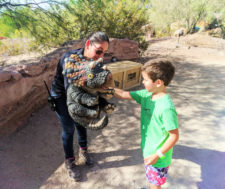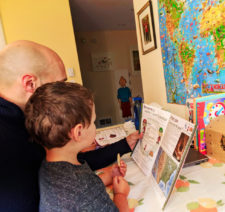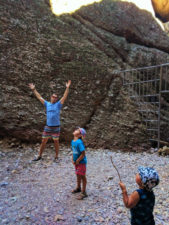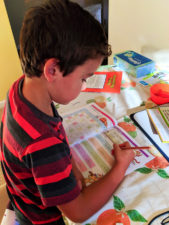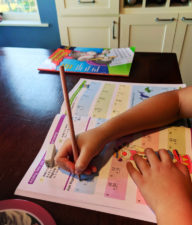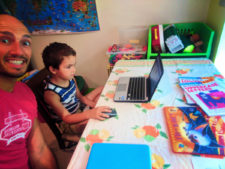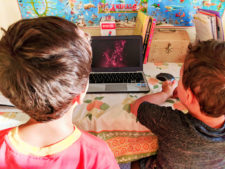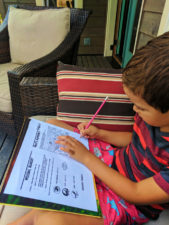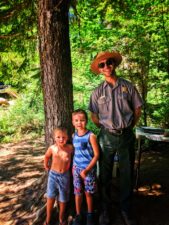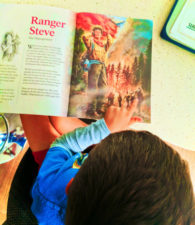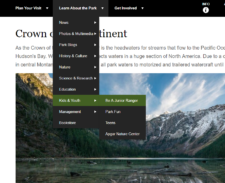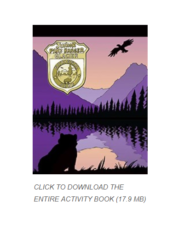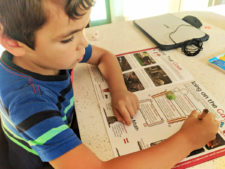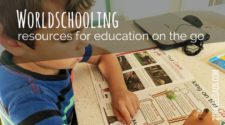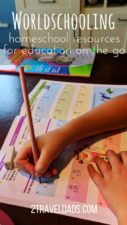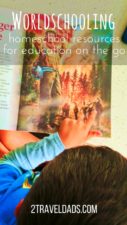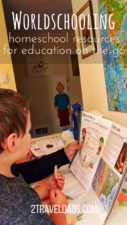Starting out on our worldschooling adventure was more than just the decision to homeschool, but it was also figuring out what we’d be using for curriculum and technology. Homeschooling resources are all over if you just know where to look, from full on education plans and online teaching programs to local events and public parks. But how do you put all of these pieces together to successfully launch into educating your kids outside of the public school system.
Note: take a look at our article about our decision to worldschool our kids. We started this journey after lots of research and consideration, so go peek into what we talked about and where we landed in terms of homeschooling and how education fits into our family.
What homeschooling resources do we use?
If you ever want to have a good laugh start doing research on homeschool curricula and tools. It’s a never-ending blackhole of blog posts and reviews, both overwhelming and hilarious. Here’s how we roll though.
Making and keeping an education plan
When we first made the announcement that we were going to homeschool the kids, one of our good friends, who is a teacher by trade, immediately questioned what our plan was to make sure that we weren’t just going to wing it. So one of our first resources we use is our network of friends that we can bounce ideas off and that will hold us accountable. True, we are the ones who are going to most closely be able to monitor and see how the kids are learning and developing, but it’s invaluable to have people who can keep you in check and make sure that you aren’t just living in your own bubble of perceived perfection.
If you can leverage other parents or those you know who work in education to ensure or validate that you are taking a proper or effective approach, you should. I’m not saying to be fully invested in every little bit of advice or ask somebody else to build your education plan, but to surround yourself with those who have either already sailed this sea or have the formal education to properly advise you. Worldschooling will only be an acceptable education method in society’s eyes if those of us doing it actually do a great job educating our kids.
Worldschooling workbooks and traditional text
The next of our homeschooling resources we use is a collection of tangible work books. In a world that’s so full of technology it’s easy just to find everything online and roll with it. We thought about tactile learning though and the connection of writing something and remembering it, and we determined that we wanted to have a solid approach to keeping the connection between learning with your hands and storing things in your brain. Also, this ensures that we teach our kids proper penmanship and how to function without a computer.
Note: cursive and other formal penmanship techniques aren’t taught in many schools today. If you’re not homeschooling but you see value in cursive, Duvall, or other penmanship techniques, it’s worth it to teach at home.
And when it comes to math… who wants to chat about Common Core? Bueller? Bueller?
So, if you’re new to modern public school in America, Common Core is the current method for teaching math starting at an early age. While some aspects of it are really great for kids that learn in a certain way, such as through visual grouping or blocking, when it comes to explaining very basic concepts, it’s kind of a disaster. As an adult who learned math systems that allow me to do accurate and fast calculations in my head, including multiplication processes, Common Core is my own personal wasteland. Homeschooling allows us to teach the kids common core from the start AND the basic math and processes we learned as kids: the best of both worlds.
Tip: take a moment to watch this video about Common Core to get a little insight into why this awkward new math is taught. You can still be angry at the world, but at least this will help you understand.
Our learning materials
Handwriting: Printing Workbook (Brighter Child: Grades K-2)
Workbooks-Addition and Subtraction Grades 1-2
Spectrum Math Workbook, Grade 1
Kumon Learning systems – Math, Lowercase and Uppercase writing
Lined paper – for practicing handwriting, working out math problems and more
Technology Based teaching and tools
We do use technology-based teaching (TBT) also. We use it as a way to stay current with education guidelines and trends, but we also use TBT as a way to ensure the kids stay engaged. Something that was always great about elementary school was when you got to actually leave your classroom and head to another teacher for art or PE or something… or computer lab (dating myself). TBT partially fills that gap: the alternative engagement/teacher that we don’t usually find while homeschooling the kids.
Having part of the curriculum function off of TBT also makes it easy to take with us on the road. I mean, we are talking about worldschooling. We got a good, sturdy laptop that is specifically for school and then we also have a collection of learning apps and games on both our Kindle Fire and our iPad. The combination of these three electronic tools make for a varied experience when it comes to TBT as well as it provides a backup if we can’t do one aspect of our learning.
Tip: our youngest isn’t quite school-aged yet, but loves to do “schoolwork” so when we’re doing homeschooling sessions, he’s often do one of our learning games on one of the tablets. It gets him involved and he gets to learn too.
Our worldschooling technology
ASUS Chromebook C202SA-YS02 11.6″ Ruggedized and Water Resistant
Kindle Fire HD 8 Tablet with Alexa, 8″ HD Display, 16 GB
Epson WorkForce Pro WF-3720 Wireless All-in-One Color Inkjet Printer, Copier, Scanner
Our Worldschooling computer programs/apps
Time For Learning – math, science, language arts curricula – paid membership
KidzType – elementary typing platform – free access
Web Ranger – free through National Park Service
Endless Alphabet – tablet app for letter sounds and articulation (Endless Reader & Endless Spanish also available)
DuoLingo – free language platform for beginning learners
Khan Academy – free learning programs of every kind and learning level
Applied learning packets
It’s so easy to work in fancy phrases when you’re talking about education. When we mention applied learning we are talking about education concepts that your kids can easily put into action or understand once they are out in the world.
Our favorite type of applied learning tool is the National Park Service Junior Ranger program. We actually have been doing this longer than we knew we would be worldschooling, so it made for an easy transition when it came time to start building lesson plans based off of our travels. Junior Ranger packets include aspects of History, Science, Art, and basic educational games. While this isn’t a long-term solution as the kids continue to develop and need more challenging work, this is perfect for our young kids who are just starting their education journey, and we visit so many National Parks it only makes sense. We do so much work and travel here within the United States that incorporating Junior Ranger programs is very simple and is a readily available resource really anywhere we go.
How to access Junior Ranger Programs
The first thought most people have about Junior Ranger through the National Park Service is that you can do Ranger talks and complete workbooks while you’re actually in a National Park. While that’s true, you also can access many parts of the Junior Ranger Program online and use them for one of your homeschooling resources. Each NPS website with an available online program has a tab on their web page under either Education, Learn About the Park, or Kids and Youth section where you can access the curriculum.
Most of the available online Junior Ranger programs are available as PDFs and can be completed on the computer with Adobe Writer or printed off. We typically print the packet when we know we’re going to head to a park so that we can do it on the go without technology and then present it at one of the visitors centers (and we get a badge for those ones). Also, since many packets will have activities that are more than words, we usually end up printing the packets anyways.
Tip: some NPS sites have Junior Ranger Packets in multiple languages. This is great for kids either learning a second language or whose first language isn’t English. Example: San Juan National Historic Site in Puerto Rico has multiple languages available at all times.
Another way you can leverage the Junior Ranger Program is for less specific parks, but broader concepts, such as cave science, geology, night sky… Between the many Park curricula and the broad topics, you could use and re-use many of the packets over the journey of worldschooling. The National Park Service is good about updating topics and content, so even if you’ve previously reviewed a program it may be fresh the next time you approach it.
See?! We’re totally set up for having a great and beneficial worldschooling experience. Our homeschooling resources are plentiful and varied. Already we’re learning what programs and processes work well for our kids and we’re adjusting our approach as we go.
If you have suggestions or idea either around worldschooling or additional homeschooling resources, we’d love to hear. Feel free to leave a comment or send us a message with your thoughts.
And please pin this article for later if you’re thinking about homeschooling, worldschooling, or un-schooling your kids. It’s a journey that we can all learn from together.

